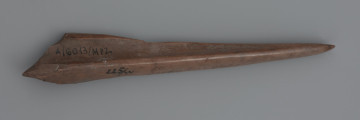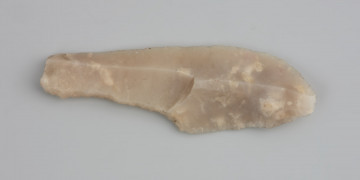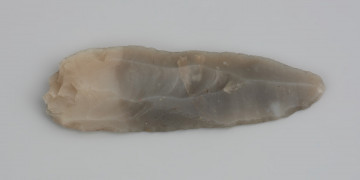
Perforator
9600 p.n.e. — 4100 p.n.e.
National Museum in Szczecin
Part of the collection: Bronze Age
The dagger made of arsenic bronze found its way to the collection of the Society of History and Antiquities of Pomerania (Towarzystwo Historii i Starożytności Pomorza) in Szczecin, most probably at the beginning of the 19th century. It consists of a triangular head with a distinct central strengthening rib and a very narrow handle. It is a fascinating specimen, standing out from other daggers from the early Bronze Age. One can read from it plenty of information about the maker. The item was made quite primitively, which gives the impression that its maker was not a specialist craftsman but rather someone with poor skills. An apparent mistake of the metallurgist is the under-punching of one of the rivet holes. The shape and size of the handle are non-functional as such a small handle is impossible to grasp with a full, primarily male, hand. It might have been originally fitted with a wooden or horn cladding, which formed the actual handle. This unique dagger, dated to the younger part of the 1st Bronze Age (c. 1700-1600 BC), was probably made locally. It is believed to be an inept imitation of the excellent early Bronze Age blades known from western Poland.
Dorota Kozłowska
Author / creator
Dimensions
the entire object: height: 17 cm, width: 5 cm
Object type
thrusting weapon, stiletto
Technique
casting
Material
arsenic bronze
Origin / acquisition method
legal transfer
Creation time / dating
Creation / finding place
Owner
National Museum in Szczecin
Identification number
Location / status

9600 p.n.e. — 4100 p.n.e.
National Museum in Szczecin

11900 p.n.e. — 11000 p.n.e.
National Museum in Szczecin

11900 p.n.e. — 11000 p.n.e.
National Museum in Szczecin
DISCOVER this TOPIC
National Museum in Lublin
DISCOVER this PATH
Educational path